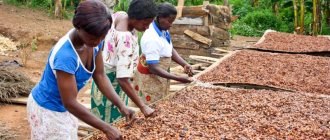Heat - rainy season - heat - for some, such living conditions will seem unacceptable, but not for Ethiopian coffee (“Kaffa Bun”). Born according to God's plan on this African soil, it became the starting point for the popularization of coffee berries throughout the world. And if at first they were simply chewed, trying to achieve an invigorating effect, then later the harvested crop was cleaned, ground and became the basis for preparing a drink with an amazing taste and aroma. Step by step, the unique product was refined and won recognition from the inhabitants of the entire planet.
History of Coffee in Ethiopia
Even in ancient times, people began to consume parts of the coffee tree in their diet. And the first to discover coffee were the Ethiopians - a population living before our era in the province of Kaffa - this is Ethiopia in our time.
The fruits were crushed and combined with animal fat; edible balls were formed from this mass, which they carried with them to refresh themselves. The juice extracted from the fruit was used to prepare a drink reminiscent of wine, and the leaves were brewed to produce an analogue of tea.
Only over time, Ethiopians began to heat water and use coffee beans to prepare the drink. Such drinks were initially part of rituals associated with religion. And Ethiopian coffee became a drink of national importance much later, a national drink. Wood processing: the process of collecting leaves and grains, has become a separate craft.
Ethiopia is the birthplace of coffee
According to ancient legends, a resident from the province of Kaffa, while grazing a herd of goats, discovered strange berries. Having tried them, he felt cheerfulness and energy, so he hastened to share his find with the believing hermit.
He did not listen to the shepherd and ordered to immediately get rid of the hellish fruits by throwing them into the fire. But everything changed when the aroma of coffee began to spread throughout the area, they began to take out grains and fire and pour water on them. So, by absolute chance, they discovered the original drink.
Ethiopia is the birthplace of coffee
For many years, the debate has not subsided over what can be considered the fundamental basis of everyone's favorite drink - Brazilian coffee or Ethiopian. In fact, there is no reason to belittle Ethiopia's credit for growing the first coffee trees. Yes, today Brazil is a leader in the production and export of coffee products! However, Ethiopia was, is and will be the birthplace of coffee.
According to the stories of our ancestors, in this country the local resident Kaldim, together with his goats, came across miraculous berries. Fascinated by the invigorating effect of Ethiopian coffee beans, he hastened to share his discovery with the Islamic devotee. The latter, due to his religiosity, did not believe the shepherd and advised him to throw the demonic berries into the fire. However, when a charming aroma floated around the area, the believer changed his mind and rushed to rake the smoldering coals. Coffee beans were collected, filled with water and, without realizing it, became the forefathers of the drink popular today.
Growing and processing conditions
Ethiopia is a country, the main part of which is located at an altitude of one and a half kilometers above sea level. Basically, profitable products are produced on small farms, with a volume of more than three hundred thousand tons per year.
The country's tropical climate is optimal for growing coffee trees. Locals are engaged in harvesting from August, until January. The main variety of Ethiopian coffee grown here is Arabica, although its varieties are also found in some areas of the country.
Most of the coffee trees grew in nature on their own, and people only had to pick the ripe berries. This wild Arabica, devoid of care, produces a small harvest, and it is very difficult to collect berries in the thickets of the forest, so it is possible to obtain about twenty kilograms of raw materials per day.
About a third of the total harvest is harvested in special prepared areas. The soil is fertilized with special substances without using chemical components.
The local authorities did not deign to produce the necessary documents for Ethiopian coffee, so export occurs without the appropriate certificates.
Coffee cultivation in Ethiopia is facilitated by favorable climatic and landscape conditions - namely:
- special natural conditions - provides natural watering in the form of rain, and excellent protection from the sun - huge trees,
- mountainous terrain and soil near volcanoes, very fertile,
- absence of bad weather events and sudden temperature changes.
Ethiopia grows most of its coffee beans not on plantations, but in forests:
- wild trees are profitable because they produce the harvest themselves and producers do not have to plant seedlings. The soil near the volcanoes provides fertilizer and the rain provides watering.
- The disadvantage of wild coffee trees is that they grow at different heights and harvesting cannot be automated. This creates enormous human labor costs, although it solves the problem of jobs for the population.
Types of coffee and its classification
In Ethiopia since the 19th century. The following types of coffee were distinguished:
- Xapapu (grown in the vicinity of the Ethiopian city of Harare, famous for its quality, thanks to which it gained great popularity);
- Abyssinia (coffee collected from trees growing wild throughout the country).
In addition, varieties called Geisha and Wush-Wush, Rume Sudan, were discovered in Ethiopia.
Today the following categories of coffee are distinguished:
- Wild or forest.
This category includes grains that are collected from wild trees, mainly in southwestern Ethiopia. This does not take into account their variety.
- Garden.
This is the basic variety of coffee. It is collected from trees planted either near housing or around the farm. The trees are provided with certain care and even feeding.
- Farm-grown coffee.
Coffee grown on large farms where standard tree care and selection are used to develop varieties that are resistant to various diseases.
This gradation is based on the production method.
If we talk about the classification of Ethiopian coffee, it was introduced by the coffee exchange, where the harvested grains go. In warehouses, it is sorted, and the coffee is assigned one number or another depending on the region of origin. In this case, coffee that has undergone washed processing can be assigned a number in the range from 1 to 10 ; Naturally processed coffee received the number 11 . Next, the grains were distributed in accordance with the quality scale. It is also presented in the form of numbering (1 – 9) or UG marking. The latter means that the coffee in the package is not classified.
The classification process takes place before the auction begins. Thanks to the introduced designations, buyers have the opportunity to find out the region of origin of coffee and its quality.
Ethiopia is an amazing country where coffee is cultivated with unique taste characteristics. This country is the birthplace of Arabica and (today) ranks fifth in the global coffee industry in terms of volumes produced. Ethiopia produces coffee both for its own consumption and for export. About 20% of the population is involved in this industry in one way or another. The total volume of coffee production reaches 350 thousand tons annually.
Technologies for growing and producing coffee in Ethiopia
The terrain features of Africa force us to grow coffee trees together with banana trees, but this only has a beneficial effect on the result, because they perfectly nourish the soil and protect well from wind and temperature fluctuations.
Ethiopia is a country with a low standard of living, and innovations in coffee processing are not known here. Processing of raw materials occurs in a dry way and is done manually.
- the harvested crop is simply dried under the sun on the leaves of a banana tree,
- drying the grains takes half a month, during the entire time they are regularly mixed and protected from pests,
- when the percentage of water in the grains reaches twelve, they begin to be cleaned,
- The grains are cleaned using a sieve and sorted.
This processing method does not exclude the entry of low-quality grain, but the quality of taste does not suffer from this.
Wet processing technology requires significant financial costs and requires the availability of clean running water. Therefore, it is used less often and a small percentage of the crop is processed in this way. Coffee that has undergone this type of processing has a pure taste, but its price is much higher than usual.
The consumer can determine the method of processing Ethiopian coffee using special markings and descriptions, where the wet method is designated by the numbers 2, 3, and the dry method by 4 and 5. But the surest way to determine the best is the personal taste sensations of the taster.
Recently, in order to maintain product prices and to control the quality of the finished product, all Ethiopian coffee on the market is presented under the sign of the Ethiopian Commodity Exchange. This has negatively affected the individuality of the varieties, and it is now impossible to find out details about the product.
Real Ethiopian coffee, prepared using the wet method, at affordable prices, is always in stock in our online store.
What kind of coffee should I bring from Ethiopia?
Since traveling to Ethiopia is necessarily accompanied by the purchase of coffee, you need to know the specifics of purchasing it. Despite the fact that the country provides labeling of the finished product, the packaging of real Ethiopian coffee may not have special badges confirming the manufacturer’s license or the environmental friendliness of the product.
The quality of coffee can be determined by the intensity of roasting. To preserve the unique aroma and rich taste of the grains, they are not subjected to severe heat treatment. A high-quality product has a light caramel shade.
When purchasing, remember that real coffee cannot be cheap. A kilogram of roasted Ethiopian grains costs at least three thousand rubles.
Hand-picked Arabica
The large-scale export of coffee to markets in neighboring countries did not make Ethiopia a rich state. Therefore, coffee is grown mainly by small farmers, and the main processes are performed manually. Collecting fruits is a complex, meticulous process and requires a lot of experience from workers. Drying of grains is also not automated and therefore occurs gradually.
Ethiopia is the cradle of coffee, because from Africa it spread to other continents.
Types of coffee by grain size and other features
Good Ethiopian coffee is never heavily roasted, as the manufacturer tries to bring out the full range of flavors. If the grain is purchased by packers from France, Italy, Spain, then you can find almost black coffee there, very strongly roasted, which lacks some flavor characteristics.
Arabica beans are sorted by bean size. This is necessary not so much for increasing the cost, but for uniform roasting, since small and large specimens will not warm up equally.
Most often in Ethiopia you can buy single varieties, which are described above, but there are also blends, the cost of which is lower.
Ethiopian coffee varieties
Only the best beans, selected by the calloused hands of local aborigines, create Ethiopian coffee, and care and knowledge of the matter help to separate Arabica varieties:
- Arabica coffee Ethiopia Harrar is an elite variety from the province with the same name. The technology of roasting the beans gives the taste of chocolate, a slight sour taste, which makes the variety ideal for moccacino.
- Multifaceted Lekempti is a coffee variety from Ethiopia, distinguished by its aroma of fruits and flowers, and a slight astringency.
- Limu is an Ethiopian coffee made from round shaped beans, and therefore has a special taste and aroma.
- Ethiopia Sidamo coffee is coffee from the mountaintops, infused with plant aromas that reveal grape and floral notes. The coffee beans are medium-density because they are dry-processed.
- Arabica coffee Jimma is a variety that forms a dense foam when cooked, has a tart taste with a grape tint, and retains a pleasant aftertaste for a long time.
- For the mixtures, a coffee variety called Tepi is used. The coffee is rich in the smell of lime and light citrus sourness.
- Irgacheffe coffee is a purely aristocratic variety that is suitable for both mixing and drinking on its own. Irgacheffe coffee has a rich tart taste with spicy and floral notes.
- Ethiopian coffee beans are distinguished by fruity notes, which are imbued with them from nearby trees bearing sweet fruits.
Coffee industry
The origins of coffee are still unclear; there is no evidence of where it grew in Africa before the 17th century. The most famous legend of his discovery is about an Ethiopian shepherd named Kaldim and his goats. Every day the man was busy grazing his animals. He noticed that the goats chewed the leaves and red berries of one plant, and then always became more cheerful and “danced.”
Kaldim reported this observation to the abbot of the local monastery. He, in turn, tried the decoction of the mysterious plant and felt a surge of strength. He was so imbued with the miraculous effect that he taught all the monks to drink this invigorating drink so that they would not fall asleep during services.
Many legends and stories about this drink have survived to this day. It is not known which version is correct, but the truth is that coffee is the heritage of Ethiopia.
Almost 460 thousand hectares of its entire area are covered with coffee trees. These can be either small private plantations or huge fields, with good care and technical equipment. In addition, most of the local coffee is collected from forest trees, because this country is the only one where it exists in the wild.
The average vegetation density is 10 thousand units per hectare in the forest zone and 3.5 thousand expensive plantation varieties. From 200 to 360 thousand tons of Arabica coffee beans are harvested from them per year, making Ethiopia the largest African supplier. Most of the harvest remains in the country, for the needs of the residents themselves. Coffee exports from Ethiopia bring about 70% of the budget's income.
Exclusive varieties of Ethiopian coffee beans
On the world stage, each country stands out with some special product, as national pride. In a country with the amazing name Ethiopia, there is a special product - coffee. Ethiopia coffee is a one-of-a-kind raw material, the export of which to different parts of the world is under strict control.
The variety of varieties of this coffee is impressive, but the main three should be highlighted based on taste characteristics:
| Ethiopia Yirgacheffe - fractional grain grown in the province of Sidamo, and processed using a wet method, and therefore is considered elite. When cooked, it is an amazing product with a fruity floral aroma and a chocolate and citrus taste. |
| Ethiopia Sidamo (ethiopia sidamo) - coffee from the south of the country, which is processed in an expensive way, because it is famous for the taste of chocolate and aroma of bergamot, with the sourness characteristic of Arabica coffee. |
| Ethiopia Harrar ( Ethiopia Mocha Sidamo ) is coffee made from forest beans, therefore it has a nutty-citrus taste and a moderately sour and bitter aftertaste. |
Ethiopian coffee
Traditionally, Ethiopians choose medium-roasted beans for the coffee ceremony, and use one of the following methods for brewing:
- The first method is to put ground coffee in a container and place it over a cup, then pour hot water, it slowly passes through the powder, into the cup is called a “dripping” filter.
- The second method is when ground coffee is poured with boiling water in a cup.
- “Cold brew” is a method in which coarsely ground coffee is mixed with water in a ratio of one to four and left to brew for more than ten hours.
How to prepare a drink in the style of “Ethiopia coffee”?
Coffee in the “Ethiopia coffee” style is reminiscent of an ancient ritual, and is prepared in the presence of all household members and guests. The roasting stage and the subsequent grinding of the finished beans take place. Ground coffee beans are poured into special containers.
The first portion of coffee is intended for the owner and all men present, the second portion is consumed by the female representatives, the next portion is poured to the children. A person who comes to a house, in order to respect the owners, is obliged to drink several cups of this drink.
How to prepare Ethiopia coffee is as follows:
- The owner lights the herbs in the house, which, when burned, envelop everyone present in the house, thus protecting them from evil spirits.
- The grains are washed in running water and then fried over a fire for several minutes.
- The aromatic grains are shown to the guest to evaluate the magic of the aroma.
- Then the housewife grinds the finished coffee beans in a mortar.
- The ground coffee powder is poured into a container, water is poured in and brought to a boil.
- Often incense was thrown into the fire where coffee was brewed to intensify the aroma.
- The finished drink is passed through a filter and filled into small cups without handles.
Taste the finished drink with honey, adding aromatic spices or oils, roasted nuts or barley, and also complementing the taste with homemade flatbreads.
Video. How is coffee grown? Ethiopia.
Video. Coffee Ethiopia through the eyes of Sergei Mitrofanov. Part 1
Where to buy Yirgacheffe coffee?
You can purchase “Yirgacheffe” in a specialized online store. Such organizations supply coffee to branches of their network, then it is roasted immediately before sale and packaged in small batches. If necessary, grind the coffee. Delivery is carried out by transport companies. The natural product has such strong aromatic properties that you can smell it even through the packaging.
True coffee lovers should definitely try Yirgacheffe coffee, because only then will they be able to form their own opinion about it.
We'll be glad to know him. Taste new coffee varieties and share your impressions. This is how we put together a mosaic of coffee tastes and preferences. In the Coffee-kitchen section | Tags: Yirgacheffe, Irgacheffe coffee | Comments (0)











